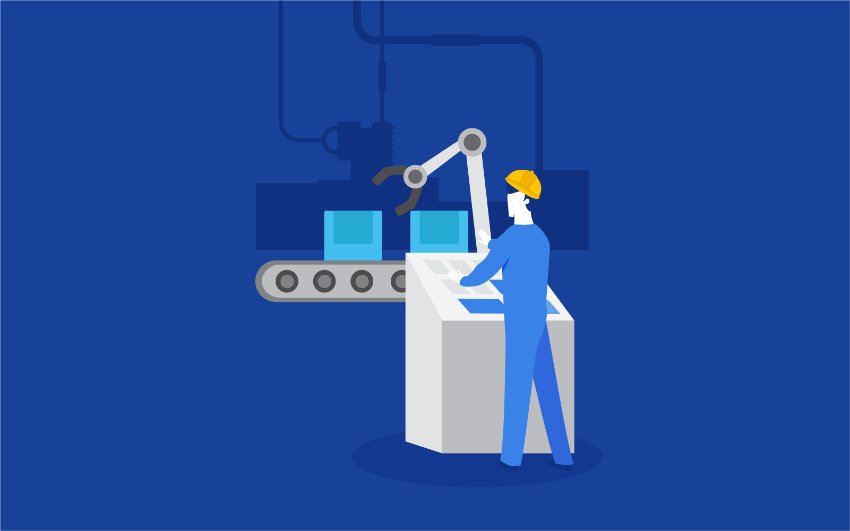Three obstacles manufacturers must overcome to build the factory of the future
As manufacturers rapidly evolve to prepare for a technology-driven future, they face significant challenges reskilling the workforce, increasing productivity, and retaining employees. Here are three challenges – and solutions – manufacturers face as they build the factory of the future.

It's an exciting time to be in the manufacturing industry right now. The need to stay competitive in the context of globalization and consumer-driven production increases has led to a fourth industrial revolution (Industry 4.0). Manufacturers are adopting cutting-edge technology at a fast pace to increase productivity and efficiency, but the movement is creating significant workforce challenges for companies to navigate.
Successfully tackling these challenges with proactive solutions will give companies the competitive edge of an efficient, engaged workforce that’s prepared for the future of work. Here are three challenges manufacturers should consider as they build the factory of the future.
Download the guide, Manufacturing the future: Building a next-gen workforce for Industry 4.0
Challenge 1: Meeting production goals in a tight labor market
Today’s labor market is tight – in fact, the U.S. unemployment rate is at a “near-generational low” of 3.9%., while manufacturing jobs have been growing at double-digit rates since mid-2017 and are nearing a historical peak. Today’s manufacturers need to keep production levels high to stay competitive, but they can’t always count on being able to hire the right workers quickly. Instead, manufacturers may need to focus on other strategies to ensure critical roles are always covered and the business can take on new opportunities that arise.
Solution: Embrace succession planning to ensure business continuity
One often overlooked way to ensure business continuity in a tight labor market is succession planning. This strategy is still primarily used to groom talent for leadership roles: 60% of HR professionals cite preparing future leaders as the top reason for creating a succession management plan, yet only 20% feel they’re adequately prepared for any employee in a key position to leave.
Manufacturers should create a succession planning strategy that includes critical, non-management roles to minimize risk to production when key employees leave. Succession planning has the added benefit of improving retention for high performers who are looking for opportunities to grow and take on more responsibility.
Challenge 2: Reskilling workers without sacrificing productivity
The nature of manufacturing work is changing as new technologies are adopted to improve production. As much as 47% of today’s jobs might be gone in the next 10 years, including 20% of assembler roles. That being said, the number of manufacturing jobs is actually increasing. What’s changing is the ratio of unskilled laborers, skilled laborers, and technical specialists needed, skewing toward a higher number of roles requiring deeper technology skills.
Companies across every industry are competing for a small pool of technology talent, so reskilling existing workers in new technologies may be a more sustainable approach than hiring from outside the organisation. The challenge for manufacturers is figuring out how to reskill the workforce without compromising output.
Solution: Build a training strategy that suits the business
Manufacturers should build a training strategy that fits the specific context of their business model to successfully reskill workers. Extensive classroom learning programs may not be feasible with demanding production schedules, so manufacturers should consider other types of training, from mentoring to apprenticeships to microlearning – “bite-sized” learning moments that build on each other over time.
Personalized learning platforms –internal online learning tools – are great options because they can be adapted for different learning styles and they allow for self-service, minimizing the burden on HR teams. These platforms let organisations create customized learning paths for each employee where the system recommends modules to the learner based on their own unique context.
Learn more about the new Learning Experience Platform (LXP) – download our 2019 HCM trends report
Challenge 3: Engaging and retaining employees in a competitive job market
Retaining top talent is an important focus for organisations across industries today, but especially in manufacturing. According to Gallup’s State of the American Workforce report, only 25% of manufacturing workers feel engaged at work – the lowest of all sectors surveyed. The report shows that only 60% of workers in the sector know what’s expected of them, and few see how their roles support their organisation’s mission or believe that mission supports quality work.
Solution: Build an employee-centered work environment
Manufacturers can improve employee engagement by aligning the workforce around a big vision and connecting workers’ roles and progress back to organisational goals. Communicating the company’s strategy and goals early and often helps workers feel connected to the company.
Manufacturers can also boost engagement by investing in programs to support total wellness – physical, mental, career, and financial – while providing a personalized experience that takes workers’ individual needs into account.
Related: What is design thinking and why are smart companies applying it to HR?
Manufacturers that recognize the value of investing in the workforce as a key to Industry 4.0 success will likely have an advantage over those that focus all their attention on cutting-edge technology. It’s not enough to build the factory of the future – you need a next-generation workforce to make it matter.
You may also like:
Ready to get started?


